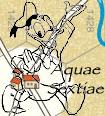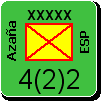Joseignacio
Posts: 2449
Joined: 5/8/2009
From: Madrid, Spain
Status: offline

|
quote:
ORIGINAL: Caquineur
quote:
ORIGINAL: lavisj
This does not apply to CVP, but to planes moving from a Sea Box back to land during naval air missions.
CVP start at the hex dot, and do not have to count from their sea box. (14.4).
You were correct previsouly in the fact that a CVP will always be in range of a hex bordered by a hex dot in the sea zone the CVP is in.
Jerome
Thanks, Jerome !
So, if I understand you correctly, the sentence "A carrier plane can fly, and return from, a port attack mission that is out of range, if the port is adjacent to any hexdot in the sea area." is useless, and could be left out in RAW future editions and RAC ?
I think my answer was directed to what the RAW call “large” hex-dots, hence my interpretation of the off-map boxes.
quote:
Unlike other wargames, the hexes stop at the coastlines. Hexes at sea are replaced by hex-dots - each hex-dot is at the centre of what would otherwise be a hex. When moving an aircraft unit across hex-dots, or when counting hexes, just imagine you are moving from hex to hex.
Example:
The use of hex-dots is partly aesthetic but also serves to show that the presence of land units is not permitted.
Some hex-dots are “large” hex-dots. Only large hex-dots are adjacent to off-map hexes. So, you can only move between a hex-dot and an off-map hex if the hex-dot is large. Large hex-dots can also be adjacent to normal hexes or normal hex-dots.
After thinking again, and reading the text again, I think Greywolf explanation is the only one I can think of, too.
|
 Printable Version
Printable Version

 to become
to become  by answering those questions ?
by answering those questions ? 











 New Messages
New Messages No New Messages
No New Messages Hot Topic w/ New Messages
Hot Topic w/ New Messages Hot Topic w/o New Messages
Hot Topic w/o New Messages Locked w/ New Messages
Locked w/ New Messages Locked w/o New Messages
Locked w/o New Messages Post New Thread
Post New Thread